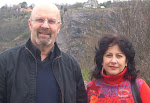A few days ago Maria Rita and I were walking through the 'centro storico' (historic part) of Nuoro when we saw an Italiano-Nuorese pocket dictionary (Nuorese being the dialect of Sardo spoken by the inhabitants of Nuoro) in a shop window. We immediately went in and bought it. After looking through the dictionary I thought it would be fun to compile a very brief Nuorese-Bristolese dictionary. It must be stressed, however, that Sardo is an officially recognised language whereas Bristolese is a mixture of dialect words and the way Bristolians with a very strong Bristol accent pronounce certain words in English! So here it is, with the standard Italian in brackets after the Nuorese words and standard English in brackets after the Bristolese words.
Pochi giorni fa io e Maria Rita facevamo una passeggiata in centro storico di Nuoro. In vetrina abbiamo visto un dizionario "Italiano-Nuorese" (Nuorese è il dialetto Sardo che gli abitanti di Nuoro parlano). Siamo entrati subito in negozio ed abbiamo comprato il piccolo libro. Dopo avere guardato il dizionario ho pensato che sarebbe stato divertente creare un dizionario molto breve "Nuorese-Bristolese". Pero, devo dire che il Sardo è una lingua ufficiale mentre il Bristolese è un misto di parole in dialetto con le parole inglesi dei Bristoliani pronunciate con un accento di Bristol molto forte. Comunque, eccolo, con le parole in italiano standard in parentesi dopo le parole in Nuorese e le parole in inglese standard in parentesi dopo le parole in Bristolese.
Nuorese (Italiano) Bristolese (English)
abba (acqua) = wau'err (water)
abilidade (abilità) = abili'ee (ability)
cuntentu (contento) = appee (happy)
diàulu (diavolo) = devawl (devil)
frebbe (febbre) = feevurr (fever)
furare (rubare) = to still (to steal)
furone (ladro) = feef (thief)
idea (idea) = ideawl (idea)
mannu (adulto) = adawt (adult)
mannu (grande) = macky (big)
mascru (maschio) = mell (male)
meda (molto) = gurt (very) or mennee (many)
muccore (muffa) = mawd (mould)
nerbosu (nervoso) = nurvuss (nervous)
pretzisu (esatto) = zackley (exactly)
pro (per) = furr (for)
risurtau (risultato) = rizawt (result)
sèmpritze (semplice) = simpawl (simple)
zenerosu (generoso) = jenruss (generous)
zero (zero) = zero (zero)























